DIY air testing to check your home for mold contaminants
Air as a vector of contamination
Many factors influence the mushroom cultivation process and harvest outcome. Contamination is one of them.
Let’s talk about how air quality (i.e. mold concentration) in your workspace affects mushroom growing processes and mycological procedures. Because the AIR is one of the main vectors of contamination in mycology.
📖 5 main vectors of contamination in mycology are: 1) the cultivator itself; 2) the AIR; 3) the substrate to be inoculated; 4) the mycelium that was being transferred; 5) the inoculating tools, equipment, containers, facilities etc.
Probably, you’ve seen many times such cases when growers accurately follow sterility rules but fail, while others totally neglect this routine and still succeed.
Of course, cultivation skills matter. However even experienced growers face contamination. They observe some patterns and periods, when contaminations appear more or less frequently.
Hopefully, it won’t surprise you, but concentration and quality of contaminants may vary from corner to corner, among the rooms, certainly between the apartments, from country to country with different climates. That’s why you will never have the same environmental conditions even with your neighbour. And, of course, cultivators from Australia, Canada or Costa Rica struggle with such contamination issues which are specific to the region they live in.
Vectors of contamination and basic principles of contamination management are fundamental for everybody. But ‘neglect practices’ from one grower won’t work for another.
Imagine 2 people who grow mushrooms in monotubs. Usually, most mold spores concentrated closer to the floor and spread with drafts. It’s better to place tubs on some podium (rack, table, shelf, etc), but don’t put them on a floor, to reduce risks of possible contamination from the air. One grower places tubs even on the floor and bragging about zero contamination. Another guy follows all recommendations and cries because of green/blue mold contamination.
❗️90% of all contaminants in the air are closer to the floor and spread by drafts. Don’t keep your fruiting chambers on the floor!
Factors that influence on the air quality
The main factors of such differences:
- Climate zone. Bacterial and mold variety, concentration, aggressiveness in moderate and (sub)tropical climates may change your “best practices” and cultivation plans.
- Season of the year. Hot/cold and dry/rainy seasons affect temperature and humidity in nature, hence the concentration of mold.
- Cleaning routine. Ventilation and air conditioning; how often you change air filters, wash your carpets and curtains, wipe the dust, clean your bathroom and kitchen; waste management (throw away food waste every day!) – everything counts.
- Pets, indoor plants, or insects play a role in the pollution level of your space becoming another vector of contamination. Pet hair spreads mold spores. Insects like fungal gnats can appear in plant pots, move to your tubs with mushrooms and destroy your harvest. Green mold that is beneficial for plants becomes a green monster for your shrooms.
- It’s funny, but depending on the climate/season, there could be a case when outdoor mushroom cultivation is more favorable than indoor.
❗️Leaking, poor ventilation, irregular cleaning provoke mold growth that affects not only mushroom growing, but human health as well!
Agar recipes and necessary equipment for DIY mold test
Let’s make a simple agar test to check the “sterility” level of your environment and the palette of contaminants in your room.
Prepare agar media. There are more than 100 different agar recipes and their variations. Use any simple recipe with ingredients you have at home. Here are a few for your choice.
Recipe 1. Malt Extract Agar recipe
- Water - 500 mL
- Agar - 10 g
- Malt/light malt extract - 10 g
- Optional - Food coloring - few drops
Ingredients on Amazon for recipe 1
- Agar $6.95
- Light malt extract, 1lb $14.00
Recipe 2. Potato Dextrose Agar recipe
- Water - 500 mL
- Agar - 10 g
- Potato starch - 10 g
- Dextrose (Glucose) powder - 7 g
- Optional - Food coloring - few drops
Ingredients on Amazon for recipe 2
- All in one - Potato Dextrose Agar Powder $33.99
Equipment
- Weight Gram scales
- Saucepan
- Tablespoon
- Stove
- Canning jar with lid or Lab Bottle
- Pressure cooker or Autoclave or Instant Pot Pot with Lid
- Reusable autoclavable Plastic Petri dishes, 6/12 Pack $11.19
- Temperature Gun $18.74
- Parafilm $39.99 or PE food film or Clear Packing Tape
Ready to use Mold Test Kit
You can also buy ready to use mold tests on Amazon and send them to the lab for accurate identification (it costs 25-40$ additionally):
- Mold Test Kit for Home - 10 Tests $45.99
Agar preparation for air sampling test
- Measure required water volume. Distilled water is typically recommended for preparing nutrient mediums. However, reverse osmosis (RO) cleaned, filtered, and chlorine-free drinking water can also be effectively used.
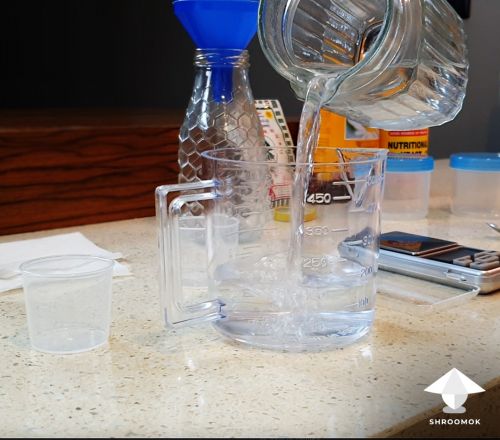
Measure the required volume of water (500 ml) You can prepare more or less, just follow the ratio of water and other ingredients
- Heat required water volume in a saucepan on the stove.
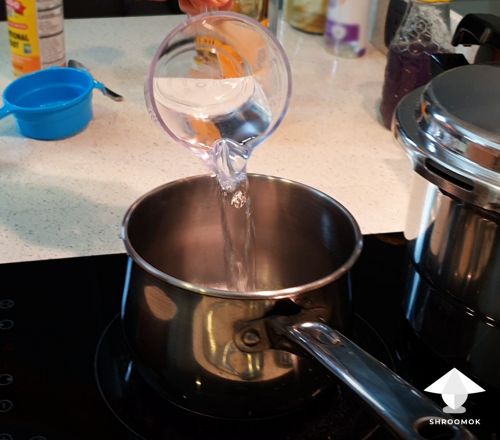
Heat required water volume in a saucepan - Weight dry ingredients according to the recipe (agar powder and nutrients like LME/Dextrose/Potato starch etc.)
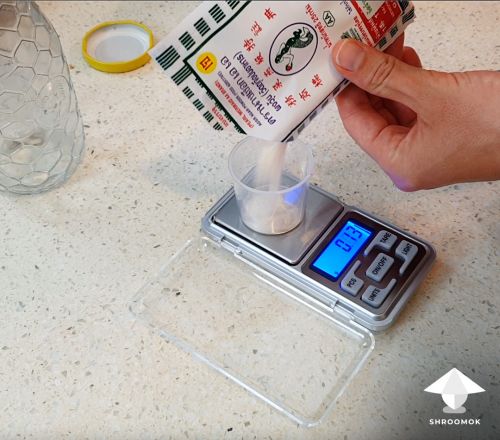
Weight dry ingredients - Dissolve all ingredients in hot water. Stir well.
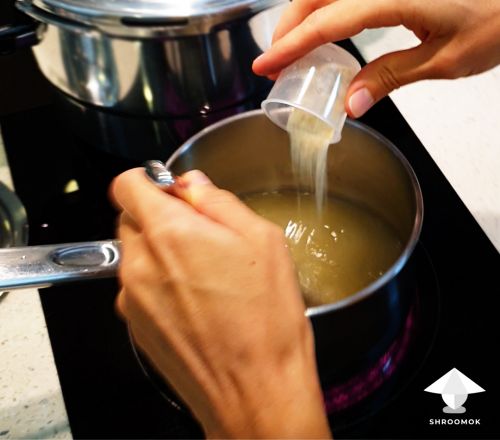
Agar cooking. Dissolve dry ingredients in hot water - Bring agar and added ingredients to boil. Turn off the stove. Ready!
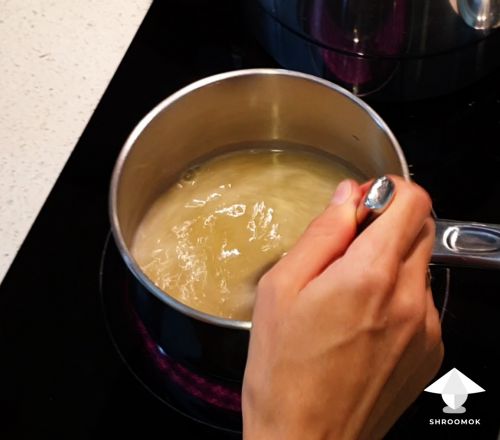
Bring agar with added ingredients to boil - Fill any heat resistant jar with lid, or canning jar, or Lab Bottle with liquid agar mix.
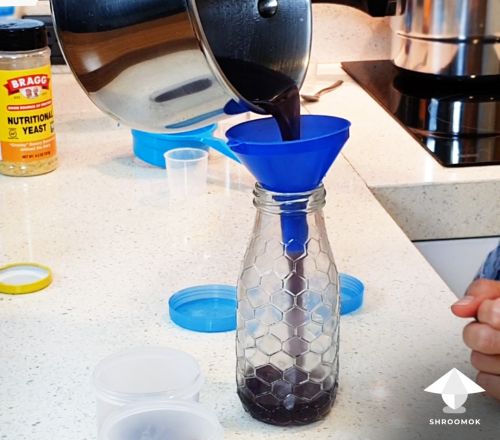
Fill the bottle with liquid agar - Sterilize agar in pressure cooker at 15 psi for 30 minutes; in instant pot or saucepan with lid for 45-60 minutes.
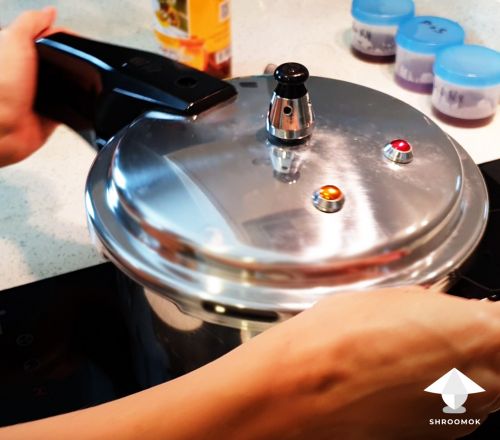
Agar sterilization - After sterilization let it cool down to 140°F or +60°C.
- Pour agar in Petri dishes. Close the lids. Let agar harden and cool down to room temperature.
💡 At 105°F or 40°C some clumps appear in agar. At 86°F or 30°C the agar solidifies. If this happen you can put the jar with agar in hot water or microwave to make it liquid again
Run air sampling test for airborne contaminants
- For testing your environment take a ready to use agar plate.
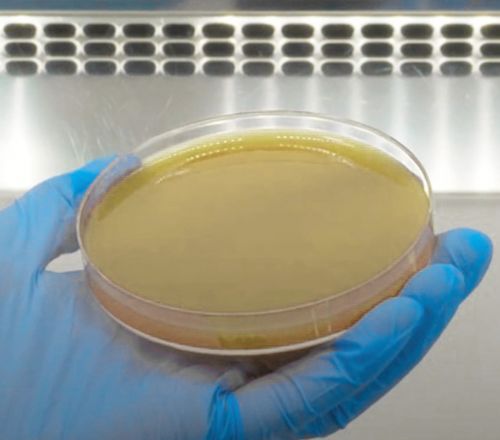
Agar plate for air sampling - Put agar plate on your work space (for example, your work table or near the tub with mushroom cake/block). Open Petri dish and leave it for 10-60 mins. The longer agar exposed to open air the more mold spores settle. You can play with different time and compare results. Start with 10 mins if you want to check your working area for mycology, 20 mins - to check grow room/tent for mushroom cultivation.
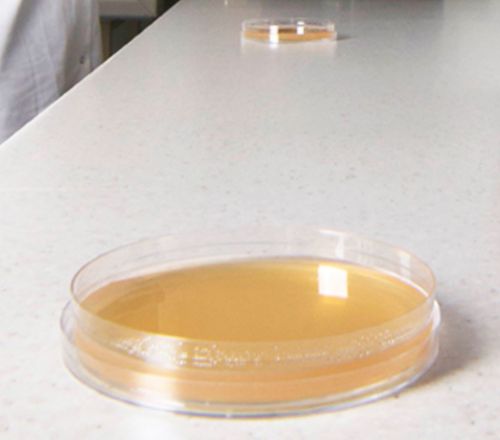
Agar plate on the working table for mycology work - Close the agar plate (use parafilm, food film, tape for fixation the lid) and leave it for incubation/colonization period at room temperature (around 72°F or 22°C) in a dark place for 48-96 hours.
- Check the agar sample. Usually, the first signs of fast growing molds appear in 48 hours.
- Check again in 3-4-5 days, you can see bright colonies development and maybe new species of molds are present in your work space.

Mold development and changes day by day
You won't confuse whether it is a mycelium or contamination, because any growth on your agar is 100% contamination.
🔬To confirm the identity of any contaminant, compare it sporulating structures with the acсompanying microscopic illustrations and/or micrographs.
Some species you can identify easily (such as blue-green mold Penicillium) or ask Shroomok Community on Discord and Reddit for approximate identification. Of course, it’s impossible to identify accurately each sample by photo. However, such capture will give insights to determine the main monsters you will fight with. Know your enemies!
Ideas and experiments on how to use DIY Mold Test
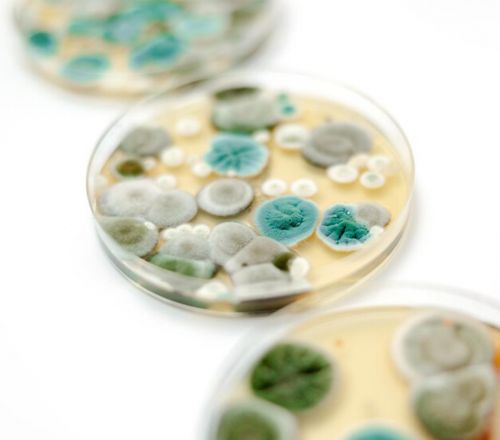
- Take air samples anywhere you want to check and compare your rooms or specific areas: grow tent, grow room, working space for mycology work, kitchen, bathroom, bedroom, basement, HVAC system.
- You can compare the difference between air samples taken at different heights: on the floor, on the table and closer to the ceiling.
- If you use a UVC light lamp for sterilization you can compare the CFUs on agar with UVC lamp vs without UVC lamp, so that you’ll see the difference and efficiency of using UVC light for mycology.
📖 CFU (Colony Forming Units) is the number of alive and active microorganisms in one serving of supplement (in our case per agar plate). These are typically measured in CFUs per gram or per milliliter. A colony refers to the individual colonies of mold, bacteria, yeast growing together. The more colonies the higher contamination concentration.
- Count the CFUs before and after cleaning the grow room/tent to know how effective the cleaning routine.
- This approach is suitable for testing SAB (Still Air Box), Fan Filter Box and Laminar Flow Hood efficiency.
- You can open the agar plate and imitate any mycological procedure. Then close the plate and check it after 2-5 days. In this way you’ll see how sterile your routine is.
- Compare indoor and outdoor samples to get a read on whether there's excess mold in your home and if it's different than what's outside.
- Compare your agar test with contaminations during cultivation process. This can help you to improve cleaning process, to know the vector of contamination. For instance, if you have totally different mold sample on mushroom block/cake, then more likely the vector of contamination is a substrate, not from airborne spores.
- Create beautiful arts with molds, bacteria, yeast. They look beautiful :)
Conclusions
Each workplace for mycology and growing room for mushrooms is unique. It differs in mold varieties and concentration level. Thus directly affects your success in mushroom cultivation.
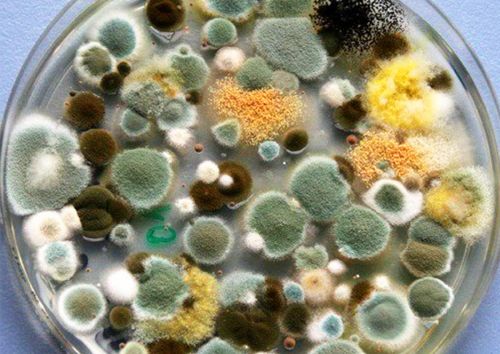
Air is one of the vectors of contamination. Remember that you can bring contamination with tools; substrate; your breath, hands and clothes; genetic materials; insects etc.
We don't live in a sterile environment, billions of spores are in the air. Simple mold test can show you the most popular varieties of mold contaminants. It’s an indicator that particular species are present in the air of your room.
There are over 100 000 different types of mold. Not all molds are a threat, however. Some species are safe for people and animals. Some molds only become toxic when they reach certain concentration. Toxic species can be harmful to individuals with severely weakened immune systems, but it needs some level to cause such problems as allergic reactions, coughing, sneezing, sore throats, asthma etc.
Don't be paranoid! We are exposed to mold spores every day and everywhere. Normally, we are capable of fighting off any inhaled or ingested mold spores. When you walk in a forest/park you breathe with billions of different mold spores. You eat some spores with food every day and gastric juice does its job.
A small patch of green mold the size of a coin on your cake or agar plate is certainly not a significant problem.
Our main concern with molds (for mushroom cultivation) is their fast growth and ability to consume nutrients faster, they are competitors with our mushrooms. They reduce the chances of a successful mushroom harvest and increase the likelihood of contamination in future attempts.
It is important to control mold contamination in our living spaces by:
- regularly cleaning, maintaining ventilation, cleaning air conditioning and ventilation filters;
- monitoring for signs of moisture and leaks in the bathroom and kitchen;
- monitoring for signs of molds on the furniture and fridge;
- throwing away trash and spoiled food every day;
- washing fruits and vegetables thoroughly.
❗️All these simple actions are preventing measures to combat molds and protect both your health and your shrooms.
Enjoy your home mycology!
Join Shroomok Community on Discord and Reddit for questions and sharing experience.
If you find this guide helpful, please support me with subscription or cup of coffee on ☕️ buymeacoffee
Peace, Shroomok ❤️


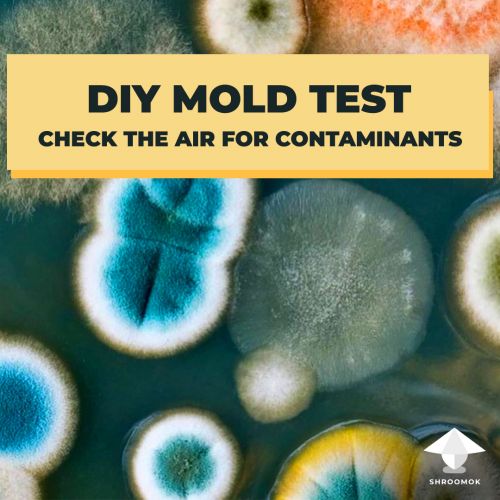
Comments
Add comment